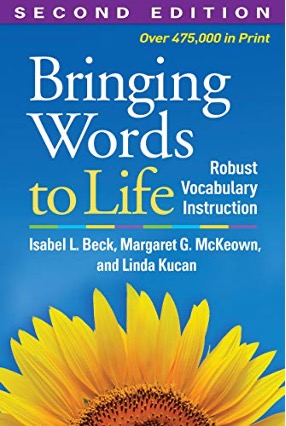
This week’s assigned podcast, ERRR #062. Margaret McKeown on Robust Vocabulary Instruction (Lovell, 2022), combined with the assigned reading, “Chapter 6: Assessing and Maintaining New Vocabulary” (Beck, McKeown, and Kucan, 2013), solidified how important it is for teachers to provide students with strategically delivered and robust vocabulary instruction that goes beyond the typical word-definition instruction seen in most classrooms. Beck, McKeown, and Kucan argue that “school vocabulary instruction tends to be dull, rather than the sort that might instigate student’s interest and awareness of words” (2013, p. 13). The authors go on to say that “becoming interested and aware of words is not a likely outcome of the way instruction is typically handled, which is to have students look up a definition in a dictionary or glossary” (2013, p. 13). If teachers want students to take an interest in words, and become keenly aware of their meaning and uses, they need to ensure that their vocabulary instruction rich, lively, and engaging. Margaret McKeown, and Bringing Words to Life, can help teachers do just this!
According to McKeown, vocabulary is the basis of all communication and should form the basis of all instruction (Lovell, 2022). As alluded to earlier, such instruction cannot be focused on definitions alone; rather, it must be robust and vigorous enough to help students with reading comprehension, be both contextual and definitional, provide students with multiple exposures and opportunities to experience words, and be interactive, engaging, and fun (Lovell, 2022). If teachers focus on the definitions of words, students will lose out on contextual knowledge and be left with a shallow (versus deep) knowledge of words (Lovell, 2022). McKeown’s robust approach piques students’ interest and curiosity of words and their relation to other words and helps them “own” words (2013, p. 14). When students come to “own” words, they become part of their vocabulary repertoires and can continually be drawn upon in conversation and in writing—both inside and outside the classroom (on the playground, at home, on the sporting field, etc.)—which is the ultimate goal!
McKeown and colleagues, in Bringing Words to Life (Chapter 4 and Chapter 5), and McKeown, in the ERRR #062podcast, outline how this goal can be reached via a fairly straightforward instructional sequence. Day one generally involves reading a text that contains six to ten “Tier 2” target words, followed by a discussion of the words (i.e. meaning of the words in the text as well as other ways the words could be used). Days two, three, and four include verbal and visual review of target words, along with several engaging vocabulary activities: examples and non-examples, word associations, generating situations, contexts and examples, sentence stems and other writing situations, returning to story contexts, and bringing in previously learned target words. Day five consists of an assessment, often modelled after one or two of the week’s vocabulary exercises. McKeown stresses, in both Bringing Words to Life and in the ERRR podcast, that assessment can come in many forms, need not be overly complex, and is dependent on purpose:
A key concept here is that many different kinds of activities can serve as assessments. What undergirds a decision on the kind of assessment to be presented is the goal of learning. If you want to know whether students have learned words deeply, that will signal a different kind of assessment than if you want to whether students can recall a brief association to a word.
Beck et. al., 2013, p. 115
McKeown also stresses that learning be continual and not end at the assessment:
[T]he assessment should not be thought of as closing the door on learning a word. Students need to continue their interactions with words across a semester or school year. The more opportunities students have to think about and use the words that they are learning, the more elaborate their mental representations of the words will be. […] This includes attention both within and beyond the classroom.Beck et. al., 2013, p. 103
McKeown provides several great suggestions to ensure that learning is continual, including: having dedicated wall space to display all learned vocabulary words; creating classroom reference resources that serve as an ongoing record of the words being learned and include word meanings and sample uses for words (i.e. a classroom dictionary and/or set of index cards, as well as individual vocabulary notebooks for older students); incorporating words into new situations and new texts; and extensions beyond the classroom (i.e. “Word Wizard” and “In the Media” challenges). All of these suggestions help solidify students’ vocabulary repertoires while reinforcing the enjoyment of words.
After this week, I urge teachers to take a good hard look at their vocabulary instruction and question whether what they are doing is robust enough. If one is even remotely unsure, she/he/they should read Bringing Words to Life and listen to the ERRR #062 podcast. There is much to take away from these resources that will greatly enrich one’s vocabulary instruction. All students deserve robust vocabularies. As such, all teachers must provide explicit and robust vocabulary instruction.
References
Beck, I., M.G, McKeown, and L. Kucan. (2013). Bringing Words to Life: Robust Vocabulary Instruction. The Guildford Press, New York, NY.
Lovell, Ollie. (2022, February 1). ERRR #062. Margaret McKeown on Robust Vocabulary Instruction. [Podcast]. Retrieved August 2, 2022 from https://www.ollielovell.com/errr/margaretmckeown-vocab/

Leave a Reply